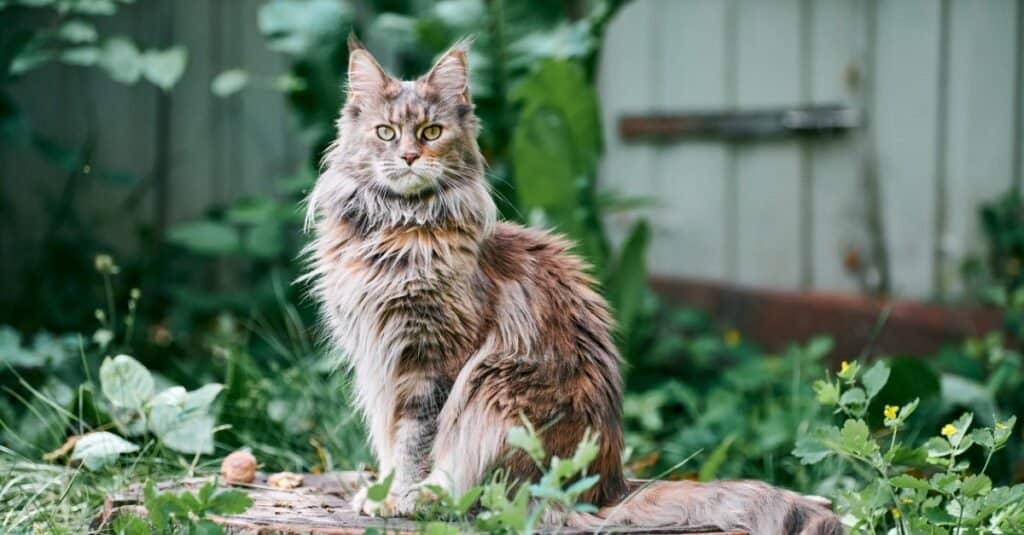Welcome to our informative article on cat age! Have you ever wondered how old your beloved feline friend would be in human years? As cat owners, it’s natural for us to want to understand the aging process of our furry companions. That’s why we’ve put together this comprehensive cat age chart that will help you discover your cat’s equivalent age in human years. By gaining insight into their aging trajectory, not only can you better appreciate the stages of their lives but also provide them with appropriate care and attention at every stage. So let’s dive right in and unlock the mysteries of cat age conversion!
Average Cat Lifespan

Cats have six life stages in total. See the cat age chart to explore them all.
©Yarkovoy/Shutterstock.com
Cats, despite their diminutive size, possess an astonishing longevity that sets them apart from other small mammals. People used to believe that smaller creatures tended to have shorter lifespans, cats defy this notion with their impressive ability to thrive for years on end. Comparatively smaller than most dogs and only slightly larger than rabbits, felines not only outlive these counterparts but also enjoy significantly longer lives.
The average lifespan of a domesticated cat typically ranges between 13 and 14 years. However, it is essential to note that individual lifespans may vary based on various factors such as genetics, environment, and quality of care provided. With proper attention and nurturing conditions, a well-cared-for cat can often surpass the average expectancy by reaching the age of 15 or even beyond.
Many resilient individuals within the feline community can reach remarkable milestones in age. We have witnessed extraordinary cases where cats gracefully navigate through their golden years into late adolescence at 18 or 20 years old—truly defying conventional expectations regarding animal longevity. Astonishingly rare instances showcase exceptional feline companions embracing life for an unprecedented span of time: unparalleled survivors who celebrate birthdays even beyond the grand milestone of a quarter-century mark.
Cat Age Chart
| Life Stage | Cat Age | Equivalent Human Age |
|---|---|---|
| Kitten Stage | 0-1 month | 0-1 year |
| Kitten Stage | 2 months | 2 years |
| Kitten Stage | 3 months | 4 years |
| Kitten Stage | 4 months | 6 years |
| Kitten Stage | 5 months | 8 years |
| Kitten Stage | 6 months | 10 years |
| Junior Stage | 7 months | 12 years |
| Junior Stage | 12 months | 15 years |
| Junior Stage | 18 months | 21 years |
| Junior Stage | 2 years | 24 years |
| Adult Stage | 3 years | 28 years |
| Adult Stage | 4 years | 32 years |
| Adult Stage | 5 years | 36 years |
| Adult Stage | 6 years | 40 years |
| Mature Adult Stage | 7 years | 44 years |
| Mature Adult Stage | 8 years | 48 years |
| Mature Adult Stage | 9 years | 52 years |
| Mature Adult Stage | 10 years | 56 years |
| Senior Stage | 11 years | 60 years |
| Senior Stage | 12 years | 64 years |
| Senior Stage | 13 years | 68 years |
| Senior Stage | 14 years | 72 years |
| Super Senior Stage | 15 years | 76 years |
| Super Senior Stage | 16 years | 80 years |
| Super Senior Stage | 17 years | 84 years |
| Super Senior Stage | 18 years | 88 years |
| Super Senior Stage | 19 years | 92 years |
| Super Senior Stage | 20 years | 96 years |
| Super Senior Stage | 21 years | 100 years |
| Super Senior Stage | 22 years | 104 years |
| Super Senior Stage | 23 years | 108 years |
| Super Senior Stage | 24 years | 112 years |
| Super Senior Stage | 25 years | 116 years |
How To Read This Chart

You do not calculate a cat’s age the same way as a dog’s age.
It is difficult to tell the age of an adult cat due to its youthful outward appearance. To better understand how to take care of our cats’ health and behavior, it is helpful to compare their age to human years. Some people used to say that you should multiply a cat’s age by 7 to get an equivalent human age. This is incorrect and does not consider various factors in cats’ maturing and aging.
A better way to calculate a cat’s age in human years is to consider the end of its first year as equivalent to 15 human years and the end of its second year as 24 years. Afterward, each cat year is equal to about four human years. You can use the cat age chart above to estimate your cat’s age in human terms, but it is important to remember that each cat matures and ages at different rates.
The chart provides information on the six distinct stages of human development a cat goes through. Scientists have determined these stages by studying how cats grow and behave, allowing us to anticipate changes in their physical and mental capacities.
Lifestage 1 — Kitten Care

Cats are in the kitten life stage until they are 6 months old.
©MDavidova/Shutterstock.com
During the first phase of a cat’s life, known as the kitten care stage, it is crucial to take proactive measures to ensure their overall health and well-being. This initial period offers an opportunity for pet owners to address any potential problems that may have been present from birth, such as congenital issues like a cleft palate or hernia. Consulting with a veterinarian during this time allows for early detection and appropriate treatment.
In addition to addressing pre-existing conditions, discussions regarding lifestyle choices play a pivotal role in setting up kittens for a healthy future. Pet owners should consult with their vet about suitable diets that meet all nutritional requirements specific to kittens. Furthermore, considering options like microchipping ensures proper identification and increases the chances of reuniting lost cats with their families.
Vaccination also plays an integral part in safeguarding the health of young felines during this stage. Discussing vaccination schedules with veterinarians ensures that kittens receive necessary immunizations against common diseases while building strong immune systems.
Behavioral issues are not uncommon among kittens, and it is important to seek guidance from professionals on managing them effectively. Vets can provide valuable information on how to establish positive behavior patterns right from the start.
Neutering is another significant aspect of kitten care that you should address when they reach around four months old. Inquiring about neutering procedures at this early age helps prevent unwanted litters while also providing various health benefits for cats later in life.
Lifestage 2 — Junior

A cat’s age when they are 12 months old is equivalent to 15 human years. See the cat age chart for details.
©Yiannis Papadimitriou/Shutterstock.com
During the junior stage, which spans from age 7 months to 24 months, your cat experiences a period of rapid growth and development. As they navigate this exciting time in their lives, it’s essential to be aware of certain health issues that commonly affect junior cats.
One primary concern during this stage is the susceptibility to important infectious diseases. Because young cats are naturally curious and adventurous, they often find themselves exposed to various pathogens. To protect your feline companion against these illnesses, it becomes crucial to ensure they receive their first booster vaccination around the age of one year. This immunization plays a critical role in maintaining their defense against common infectious diseases.
Additionally, as your cat matures both physically and emotionally during the junior phase, paying attention to its environment becomes paramount. Providing them with a safe and stimulating space for exploration is vital for their overall well-being. Keep potential hazards to a minimum. This will help prevent accidents or injuries resulting from fights, hunting activities, or trauma.
Furthermore, monitoring your cat’s diet and body weight becomes increasingly important at this stage. Most people typically neuter or spay their cats around six months of age. However, after this procedure takes place, some felines may have an increased tendency to gain excessive weight due to hormonal changes. Carefully managing their food intake through portion control and providing them with balanced nutrition tailored for their life stage can help prevent unhealthy weight gain.
Lifestage 3 — Adult

A cat’s age at 4 years old is equal to 32 human years.
©iStock.com/TRAVELARIUM
From the age of 3 to 6 years old, cats enter the adult stage of life. Common issues experienced at this time include obesity, bladder inflammation, dental decay, intestinal diseases, behavioral problems, and heart disease. If you allow your cat outside, they may still be active hunters, so it is important to be mindful of parasite control. Research has shown that over 70% of adult cats have some form of dental or gum disease, which can cause considerable pain and lead to tooth loss. Annually assessing your cat’s health can help identify any problems before they worsen. In cases where dental issues are present, it may be necessary to conduct a more thorough examination under general anesthesia in order to clean and treat the teeth.
Including some dry cat food in their diet can help keep their teeth clean, but the best way to keep their teeth shining is to brush them. If you’re interested in brushing your cat’s teeth, start as early as possible and get a toothbrush and toothpaste made specifically for cats from your vet. Never use human toothpaste or products on your feline. They are not suitable for cats.
Lifestage 4 — Mature

After a cat’s age reaches 7 years old, they are in the mature adult stage of life.
©iStock.com/slowmotiongli
During the mature adult stage, which spans from age 7 to age 10, cats may still maintain a youthful appearance and exhibit playful behavior. However, it is during this phase that owners should be mindful of potential age-related health issues that could arise. Older cat diseases, such as diabetes, high blood pressure, kidney disease, cancer, and hyperthyroidism, become more prevalent at this stage.
To ensure the well-being of their feline companions, pet owners should closely monitor their cats for any signs of illness or discomfort. Common indicators of disease in older cats include a deterioration in coat condition, fatigue or lack of energy, change in weight without explanation, episodes of vomiting or diarrhea, changes in appetite or thirst patterns, alterations in urination habits (such as increased frequency), and reduced overall activity levels.
In addition to these health concerns specific to aging cats, obesity becomes a heightened risk factor during both the mature and senior stages. Consequently, you must exercise extra caution when feeding these pets. Changes in body weight can easily go unnoticed over time—particularly for long-haired cats—and identifying them can prove challenging. Therefore consistent weighing practices and monitoring their body condition score are crucial preventive measures.
Lifestage 5 — Senior

Senior cats have different health issues and nutritional needs than their younger kin.
©sophiecat/Shutterstock.com
From ages 11 to 14, you can consider your cat in the senior stage of life. During this period, your cat may be more susceptible to a variety of health issues, such as high blood pressure, overactive thyroid glands, kidney disease, arthritis, cancer, and diabetes. Additionally, your cat may show signs of senility, such as confusion, withdrawal, aimless wandering, and excessive vocalization. It is important to take your cat for a full examination if you notice any of these changes, as they can be indicative of a variety of diseases.
As cats age, they may become dehydrated or constipated. They may not groom themselves as often, resulting in coat and skin issues. Claws may grow to be too long. They may eat less due to decreased sense of smell or dental problems. Their digestive system may not work as well, and this could lead to weight loss.
Lifestage 6 — Super Senior

Cats who are over the age of 15 are called super seniors. Some of these cats live for 10 more years!
©shymar27/Shutterstock.com
Once your cat reaches the impressive age of 15, it is classified as a super senior. At this stage, you may find yourself facing similar concerns and conditions that were prevalent during your cat’s senior years. It should come as no shock that overactive thyroid, chronic kidney disease, diabetes, arthritis, and cancer continue to be recognized as the top five significant health issues affecting mature, senior, and super senior cats.
However daunting these ailments may sound, it is important to note that many of them can still be effectively managed. With proper care and attention from loving owners like yourself, even our beloved super seniors can experience a good quality of life despite these challenges.
The photo featured at the top of this post is © iStock.com/MirasWonderland
Thank you for reading! Have some feedback for us? Contact the AZ Animals editorial team.







